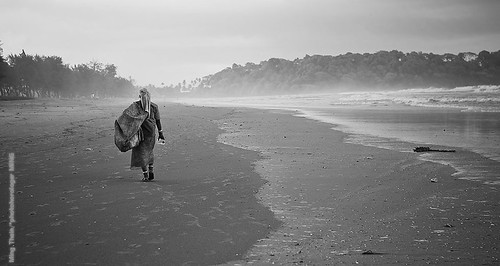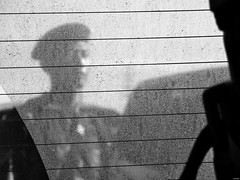
Hommage a Cartier-Bresson: Builder, Kuala Lumpur
Leica M8, Voigtlander 15/4.5 Super-Wide Heliar M ASPH II
If you look closely at the work of the great photographers of the small format era - say since Oskar Barnack defined the 36x24mm frame - it's quite obvious they have their own distinctive style, regardless of the subject or camera used.
HCB had his trademark timing; capturing the decisive moment. The ultimate ability to tell an entire story in a single image. He worked with a screwmount Leica; anybody who's shot with one of these will know what a pain it is to work with. You focus manually, through a little window, which is NOT the same as the viewfinder window. The viewfinder only shows one focal length; use an external finder or guesstimate the coverage. It gets better; shutter speed is set on two dials (one for slow speeds, one for fast speeds) due to a mechanical quirk. You have to wind it with a knob, and rewind it with another knob - but don't let go, or else the film will release itself and you'll have to start again. The meter was separate, of course. He had to work with the slow films of the day - ISO 400 being virtually unheard of, and full of grain. The upshot is a huge penalty: you pick reaction time or technical perfection, but not both. HCB did the best he could with the latter, and went for timing. It is often said that he only used 35 and 50mm lenses - true - probably because they were the fastest available, and the easiest to frame with on the early Leicas, plus offering sufficient depth of field where required. But most importantly, a wide-normal lets you have subject AND context. This is very important for photojournalism - the Tiananmen square shot would have been meaningless without the tanks behind the student. HCB's work was very much about both timing and context.

Hommage a Salgado, Canacona, Goa
Leica M8, 50/1.4 Summilux-M ASPH
Salgado uses heavy darkroom work - mostly strategic dodging and burning (though his masks could have used a little tightening up on occasion to avoid haloes) to create beautiful tonal separation of his subject from the environment. He too shot with a Leica (now Canon digital), but one with the benefit of a built in meter, lever winding, a single shutter dial, a unified viewfinder/rangefinder, and faster films. Salgado uses the background not just to support the main subject and give context, but also to blend in with the entire frame and set the mood for the image. The result: a style that looks almost like a painting. When one looks at his images, you get the feeling that it's more about the mood and atmosphere than precise timing.
Hommage a Majoli: Rush Hour, JR Yurakucho Station, Tokyo
Nikon D3, AFS 14-24/2.8 G
Majoli has settled into the digital realm perhaps better than Salgado (we believe he uses assistants for his Photoshop work, and the other two photographers mentioned here are dead). In fact, his style is defined by it. Working within the limitations of a couple of Olympus point and shoots, he uses negative space - caused by underexposure to preserve the highlight tones in the limited dynamic range recordable by the camera - to define his subjects. It's also a very stealthy, covert, gritty way of working. You feel like you're there, and you feel the dust in the air, the gravel on the ground, and fear whatever might be lurking in the shadows. Let's call it subject isolation.

Hommage Ansel Adams: Knives, Meribel, Les Trois Vallees, French Alps
Nikon D2H, AFS 70-200/2.8 VR with 2x TC
The final photographer is one who is not a photojournalist. Ansel Adams worked with large format cameras that required very precise technical skills to shoot, and first class darkroom work afterwards. He too relied on timing; the same mountain can be flat and boring, or incredibly arresting depending on the time of day and prevalent atmospheric conditions. Still, landscapes move a lot slower than life, so we'll call him the perfectionist: in control of far more variables than a photojournalist.
I'll get to the point now. The average photographer has access to equipment that has far greater potential than any of these legends - yet they somehow still managed to produce images with an aesthetic and integrity few can match today. The average cameraphone has more resolution and less lag than the Leica III that HCB used. Salgado only recently discovered Photoshop and the precision of the tools available within, as well as the control afforded by a good pen tablet. Majoli still uses point and shoots from eight years ago - with glacial shutter lag and write times, poor autofocus, and dodgy image quality above ISO 200. The pro FF cameras - D3x, 1DsIII, 5DII - have nearly as much resolution and dynamic range as what Ansel had to work with, and they don't weigh twenty pounds and required exposure times in minutes. Hell, we have cameras like the D3 that are a) affordable b) deliver comparable clean resolution to medium format film c) can shoot nine perfectly exposed, perfectly focused frames in a second d) are 256 times more sensitive than ISO 100 film e) have stunning optics available to them.
So there is absolutely no reason why - given practice - we can't produce work that is not only like these four masters, but combines the best properties of both. This is the style I'm pushing myself to deliver in my images: the timing of HCB, the aesthetics of Salgado, the grittiness of Majoli, and the technical quality of Adams. Equipment excuses are not an option. Use whatever works for you, but even the cheapest new DSLR - a Nikon D40 and a fast prime - will get you there if used carefully.
Perhaps the best takeaway is that one has to define their own style, and figure out how to get there - but most importantly, have the dedication and patience to do so.





No comments:
Post a Comment